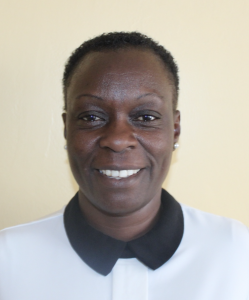"I have a big problem getting clean water, especially when there is a crowd or a queue at the spring. I take some time to allow the water to settle down and become clearer before I draw it. In addition, I waste a lot of time at the spring", explained Mr. Moses Musambai, a 42-year-old businessperson and landowner of Musambai Spring.
Musambai Spring is the primary source of water for 350 people in Isanjiro Community, but it is not serving the community members well. The spring water is dirty and difficult to access. To draw water from the unprotected spring, people have to step into the pooled water below the spring's source, trying their best to balance on slippery rocks and bricks that they use to try to stay above the water.
To aid in fetching water, community members tried to improvise a discharge pipe by inserting a plastic pipe between rocks and the earth near the spring's source. But the pipe is cracked and dirty, missing a lot of the spring's output and contaminating the water that it catches. It is also very low to the ground, so community members still have to use a small jug or bowl to fill from the pipe first, then pour into their larger jerrycans.
This process is time-consuming, tiring, and frustrating. As lines and crowds develop, tension builds over who is taking too long at the spring, even though everyone is trying their best to hurry. Time lost at the spring means delays throughout the rest of the day's activities, hurting adults and children alike in their endeavors.
"When I go to the unprotected spring to draw water, I encounter long queues which make me spend a lot of time at the spring. I first allow the adults to get water first before I do," said primary school-aged Vivian, citing a common rule of respect in her community between children and elders.
With the threat of COVID-19 looming too, the crowds are particularly worrisome to community members, yet unavoidable if they are to reserve their spot in line to fetch water.
The environment of the unprotected spring not very clean. There is a poor drainage system that causes the pooled water below the pipe and provides habitat for mosquitoes, which often harbor harmful diseases including malaria.
The most frequent cases of waterborne diseases among community members include typhoid, cholera, and diarrhea. Time lost at the spring is compounded by time lost when people become sick from the spring water. Families are draining their financial resources trying to pay for medication and hospital visits to treat their water-related illnesses, and they miss out on even more work and school time.
What We Can Do:
Spring Protection
Protecting the spring will help provide access to cleaner and safer water and reduce the time people have to spend to fetch it. Construction will keep surface runoff and other contaminants out of the water. With the community’s high involvement in the process, there should be a good sense of responsibility and ownership for the new clean water source.
Fetching water is a task predominantly carried out by women and young girls. Protecting the spring and offering training and support will, therefore, help empower the female members of the community by freeing up more of their time and energy to engage and invest in income-generating activities and their education.
Training on Health, Hygiene, COVID-19, and More
To hold trainings during the pandemic, we work closely with both community leaders and the local government to approve small groups to attend training. We ask community leaders to invite a select yet representative group of people to attend training who will then act as ambassadors to the rest of the community to share what they learn. We also communicate our expectations of physical distancing and wearing masks for all who choose to attend.
The training will focus on improved hygiene, health, and sanitation habits in this community. We will also have a dedicated session on COVID-19 symptoms, transmission routes, and prevention best practices.
With the community’s input, we will identify key leverage points where they can alter their practices at the personal, household, and community levels to affect change. This training will help to ensure participants have the knowledge they need about healthy practices and their importance to make the most of their water point as soon as water is flowing.
Our team of facilitators will use a variety of methods to train community members. Some of these methods include participatory hygiene and sanitation transformation, asset-based community development, group discussions, handouts, and demonstrations at the spring.
One of the most important issues we plan to cover is the handling, storage, and treatment of water. Having a clean water source will be extremely helpful, but it is useless if water gets contaminated by the time it is consumed. We and the community strongly believe that all of these components will work together to improve living standards here, which will help to unlock the potential for these community members to live better, healthier lives.
We will then conduct a small series of follow-up trainings before transitioning to our regularly scheduled support visits throughout the year.
Training will result in the formation of a water user committee, elected by their peers, that will oversee the operations and maintenance of the spring. The committee will enforce proper behavior around the spring and delegate tasks that will help preserve the site, such as building a fence and digging proper drainage channels. The fence will keep out destructive animals and unwanted waste, and the drainage will keep the area’s mosquito population at a minimum.

 Protected Spring
Protected Spring
 Rehabilitation Project
Rehabilitation Project













































